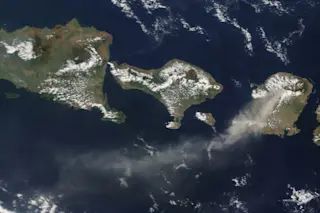The ash plume from Indonesia's Rinjani on November 5, 2015. Taken by Terra's MODIS imager.
NASA
Two eruptions are catching my attention---one big and one little. In Indonesia, Rinjani (see above) has been producing enough ash to cancel flights across the eastern part of the country, including Bali. The Barujari vent inside the larger Rinjani caldera is the culprit for this new eruption. Barujari is a small cinder cone that erupts frequently and is likely the only source of eruptions at Rinjani since the VEI 7 Samalas eruption around 1257 A.D. Barujari last erupted from 2009-2010 and typically produces small explosive eruptions that can blanket the surrounding landscape with grey ash. The current eruption follows that pattern, with explosions carrying ash as high as 4 kilometers (~14,000 feet) as it drifts west from Barujari. The ash has caused flight delays or closures at airports over 200 kilometers from the volcano. ...














